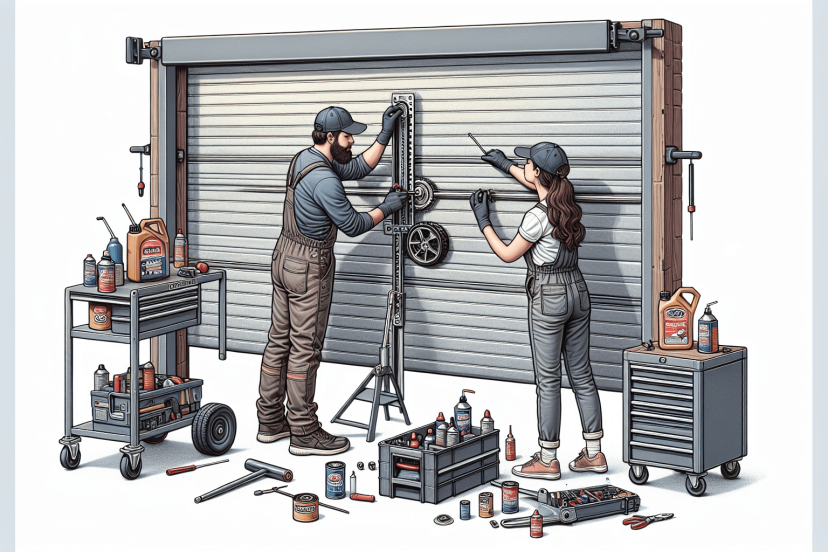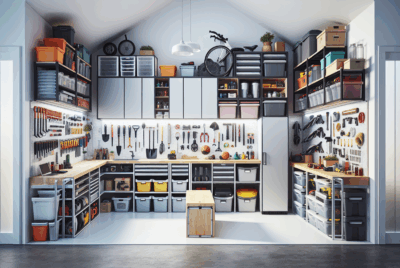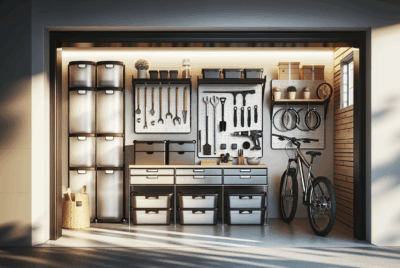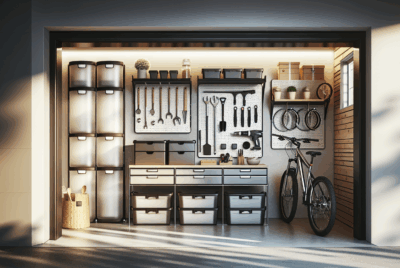How To Lubricate A Garage Door
As an Amazon Associate, I earn from qualifying purchases, at no additional cost to you. Disclaimer
I’ve got the secret to a smooth and squeak-free garage door – it’s all about the lubrication! If you’re tired of that annoying creaking noise every time you open or close your garage door, then this article is for you. In just a few simple steps, I’ll show you how to lubricate your garage door and keep it running like new. Say goodbye to those irritating sounds and hello to a quieter, more functional garage door. Ready to get started? Let’s dive in!

Understanding The Importance of Garage Door Lubrication
If you’re a homeowner with a garage, you’re likely familiar with the daily operation and functions of your garage door. As one of the most heavily used components of your home, it’s important to understand the impact that frequent use can have on its overall performance. Over time, the constant movement and exposure to various weather conditions can lead to wear and tear on your garage door. This is where the importance of regular lubrication comes into play.
How frequent use causes wear and tear
Think about how many times you open and close your garage door on a daily basis. Whether you’re leaving for work in the morning, coming home in the evening, or simply using your garage as a storage space, your garage door is bound to experience a significant amount of wear and tear over time. The constant movement of the door’s mechanical parts can cause friction, which can lead to increased strain on the system. Without proper lubrication, this friction can result in premature wear and even damage to the door.
Effects of different weather conditions on garage doors
In addition to frequent use, your garage door is also exposed to a wide range of weather conditions throughout the year. From scorching heat in the summer to freezing temperatures in the winter, these extreme weather conditions can take a toll on your garage door’s performance. Moisture from rain or snow can cause rust to form on metal parts, while high temperatures can cause components to expand and contract, leading to misalignment. Proper lubrication helps to mitigate the effects of these weather conditions by providing a protective barrier and aiding in the smooth operation of your garage door.
How lubrication extends the life of your garage door
Regular lubrication not only helps to reduce the friction between moving parts, but it also helps to prevent rust and corrosion from damaging these components. By keeping your garage door well-lubricated, you’re not only ensuring smooth and quiet operation but also extending the overall lifespan of your garage door. Without proper lubrication, the mechanical parts of your garage door can become stiff and less responsive, leading to increased wear and the need for costly repairs or replacements.
Identifying Proper Lubricants For Garage Door
Now that we understand the importance of lubrication for your garage door, it’s essential to know which lubricants are suitable for this specific application. Not all lubricants are created equal, and using the wrong type can actually do more harm than good.
Types of lubricants available
There is a wide variety of lubricants available on the market, but not all of them are appropriate for use on garage doors. When selecting a lubricant, it’s important to choose one that is specifically formulated for garage door use. Some common types of lubricants used for garage doors include silicone-based lubricants, lithium-based grease, and Teflon-based lubricants. These lubricants offer excellent protection against rust and corrosion while providing long-lasting lubrication.
Characteristics of a good garage door lubricant
When choosing a lubricant for your garage door, there are a few key characteristics to look for. Firstly, it should have a high resistance to water and moisture to prevent rust formation. Additionally, it should be able to withstand a wide range of temperatures to ensure optimal performance throughout the year. Lastly, a good garage door lubricant should provide long-lasting lubrication without attracting excessive dirt and debris.
How to choose the right lubricant
To choose the right lubricant for your garage door, consult your door’s manufacturer manual or contact a professional. They will be able to recommend the best lubricant for your specific garage door model. It’s important to avoid using WD-40 or other household lubricants, as they tend to attract dirt and can gum up the moving parts over time. Investing in a high-quality lubricant specifically designed for garage doors will ensure the longevity and optimal performance of your door.

Gathering Required Tools and Safety Equipment
Before you begin the lubrication process, it’s essential to gather the necessary tools and safety equipment. Having the right tools on hand will make the process smoother and more efficient, while safety equipment is crucial to protect yourself during the job.
Basic tools for lubrication
The tools required for garage door lubrication are relatively simple and can usually be found in most households. You will need a step ladder or a sturdy stool to safely access different parts of the garage door, a soft cloth or sponge for cleaning, and a small brush or toothbrush for applying the lubricant to hard-to-reach areas. Additionally, having a wrench or pliers may come in handy for any minor adjustments or maintenance tasks that may arise during the lubrication process.
Safety gears necessary for the job
Safety should always be a priority when performing any maintenance or repair tasks around your home, and lubricating your garage door is no exception. To protect yourself during the lubrication process, it’s crucial to wear the appropriate safety gear. This includes safety goggles to shield your eyes from any potential debris or splatter, gloves to protect your hands from any sharp or moving parts, and closed-toe shoes to ensure your feet are secure and protected.
How to safely handle lubricants
While lubricants are generally safe to use, it’s important to handle them with caution to prevent any accidents or spills. Make sure to read the instructions and warning labels on the lubricant packaging before use. If the lubricant comes in a spray can, be mindful of your surroundings and aim the nozzle away from your face and body. It’s also a good practice to have a clean cloth or paper towels nearby to quickly clean up any drips or spills that may occur.
Inspecting the Garage Door Prior To Lubrication
Before applying any lubricant to your garage door, it’s essential to conduct a thorough inspection to identify any issues or areas that may require special attention. This inspection will help you to assess the overall condition of your garage door and enable you to take the necessary steps to address any potential problems.
Checking the garage door’s mechanical parts
Start by examining the different mechanical parts of your garage door, including the springs, tracks, rollers, hinges, and lock. Look for any signs of damage, such as rust, cracks, or loose screws. Pay close attention to the condition of the springs, as they play a crucial role in the operation of your garage door and may require additional maintenance or lubrication. Inspecting the mechanical parts will give you a better understanding of the areas that may need more attention during the lubrication process.
Identifying areas that need more attention
During your inspection, you may come across certain areas of your garage door that appear to be in worse condition than others. These areas may require additional attention and maintenance. For example, if you notice excessive rust on the tracks or hinges, it’s important to clean and lubricate these areas more thoroughly to prevent further deterioration. Identifying these problem areas beforehand will allow you to allocate more time and effort to address them during the lubrication process.
Spotting signs of damage or wear
While inspecting your garage door, keep an eye out for any signs of damage or wear. This can include dents, cracks, or misalignments in the door panels, as well as fraying or breakage in the cables. These signs may indicate more significant issues with your garage door that may require professional repair or replacement. It’s important to address any noticeable damage or wear early on to prevent further deterioration and ensure the safety and functionality of your garage door.

Prepping the Garage Door
Before you begin applying lubricant to your garage door, it’s crucial to properly prepare the door to ensure optimal lubrication and to remove any dirt or debris that may interfere with the process.
Cleaning the garage door to remove dirt and debris
Using a soft cloth or sponge, wipe down the entire surface of your garage door to remove any dirt or debris that may have accumulated over time. Pay close attention to the areas around the hinges, rollers, and tracks, as these are the parts that will require lubrication. By starting with a clean surface, you’re providing a smooth and uncontaminated base for the lubricant to adhere to. Cleaning the door also allows you to get a closer look at its condition and identify any areas that may need additional cleaning or maintenance.
Removing old, dried out lubricant
If you’ve previously applied lubricant to your garage door, it’s important to remove any old or dried-out lubricant before applying a new coat. Using a small brush or toothbrush, gently scrub the areas that were previously lubricated to loosen and remove any residue. This step will ensure that the new lubricant can penetrate and coat the moving parts effectively. Removing old lubricant also prevents the buildup of excess lubricant, which can attract dirt and debris and potentially interfere with the smooth operation of your garage door.
Steps to prepare the garage door for lubrication
Once the surface of your garage door is clean and free from any old lubricant or debris, it’s time to prepare the door for lubrication. Start by closing the door completely to access the different parts that need to be lubricated. It’s important to ensure that the door is closed securely to prevent any accidental movement while you’re working. Additionally, you may find it helpful to lock the door in place to provide added stability and prevent any unexpected opening or closing during the lubrication process.
Lubricating the Garage Door Springs
The springs of your garage door are responsible for counterbalancing the weight of the door and ensuring smooth and controlled movement. Lubricating the springs is crucial to maintain their functionality and prevent unnecessary strain or damage.
Identifying different types of springs
There are two main types of garage door springs: extension springs and torsion springs. Extension springs are typically found on either side of the door and stretch or extend when the door is opened. Torsion springs, on the other hand, are located above the door and wind up or unwind to assist with the door’s movement. It’s important to identify which type of spring your garage door has, as the lubrication process may vary slightly depending on the type.
The correct way to lubricate each type
For extension springs, start by applying a small amount of lubricant to each individual spring. Using a cloth or your fingers, spread the lubricant evenly along the entire length of the spring, making sure to reach all the coils. Torsion springs, on the other hand, require a slightly different approach. Apply a thin coat of lubricant to the spring, focusing on the areas where the coils rub against each other. Be careful not to apply too much lubricant, as it may cause the spring to become slippery and affect its performance.
Safety measures while dealing with garage door springs
Lubricating garage door springs can be potentially dangerous, as they are under high tension and can cause serious injury if mishandled. It’s crucial to exercise caution and follow proper safety measures when working with springs. If you’re unsure of how to safely lubricate the springs or if you encounter any difficulties during the process, it’s best to seek professional assistance. Additionally, always ensure that the garage door is securely closed and locked before attempting to lubricate the springs to minimize any risk of the door accidentally opening or closing.
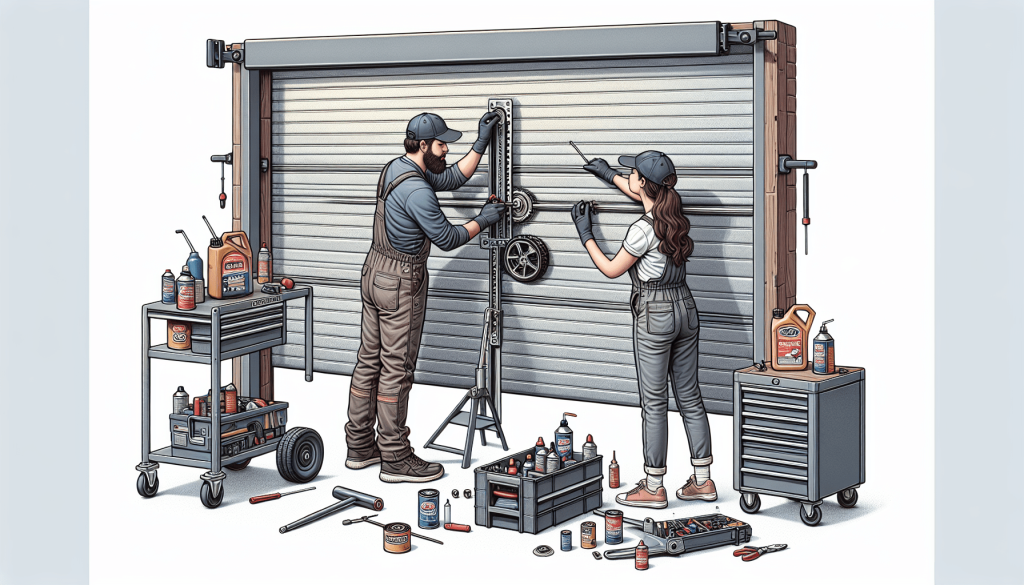
Lubricating the Metal Tracks
Metal tracks are an integral part of your garage door system, guiding the door’s movement and ensuring smooth operation. Proper lubrication of the tracks is essential to prevent friction and maintain optimal functionality.
How to properly access garage door tracks
To access the tracks of your garage door, start by opening the door partially, just enough to expose the tracks. You may need to use a ladder or a step stool to reach the upper sections of the tracks. It’s important to be cautious when working at heights and to ensure that the ladder or stool is stable and secure. If you’re unsure about your ability to safely access the tracks, consider enlisting the help of a professional.
Tips for ensuring even lubricant distribution
Once you have access to the tracks, inspect them for any dirt or debris that may have accumulated. Using a cloth or sponge, clean the tracks thoroughly to remove any obstructions. After cleaning, apply a small amount of lubricant to the inner surface of each track. Be sure to apply the lubricant evenly along the entire length of the track, paying special attention to any areas that appear dry or rusted. This will help to ensure that the lubricant is distributed evenly and fully coats the track to provide optimal lubrication.
Avoiding common mistakes while lubricating tracks
When lubricating the tracks of your garage door, it’s important to avoid making common mistakes that may compromise the effectiveness of the lubrication. One common mistake is using too much lubricant, which can lead to a buildup of excess lubricant and attract dirt and debris. It’s best to use a small amount and apply it sparingly, making sure to spread it evenly along the entire length of the track. Another mistake to avoid is using the wrong type of lubricant. Always refer to the manufacturer’s recommendations or consult a professional to ensure you’re using the right lubricant for your specific garage door.
Lubricating the Rollers and Hinges
Rollers and hinges are crucial components of your garage door, allowing for smooth opening and closing. Proper lubrication of these parts is essential to prevent noise, friction, and unnecessary wear.
Distinguishing between different types of rollers and hinges
Garage door rollers and hinges come in various materials and designs, including nylon, steel, or even ball-bearing rollers. It’s important to identify the type of rollers and hinges your garage door has, as this will determine the most suitable lubricant for the job. Nylon rollers generally require a silicone-based lubricant, while steel rollers may benefit from a lithium-based grease. Ball-bearing rollers often come pre-lubricated and may not require additional lubrication.
Ensuring all moving parts are well lubricated
Once you have determined the type of rollers and hinges on your garage door, it’s time to apply the lubricant. Start by applying a small amount of lubricant to each individual roller, making sure to reach all the moving parts. Using a cloth or your fingers, spread the lubricant evenly across the roller surfaces, ensuring that all the bearings are well-coated. Similarly, apply a small amount of lubricant to the hinges, focusing on the pivot points and any areas where metal rubs against metal. By ensuring that all moving parts are properly lubricated, you’re minimizing friction and promoting smooth operation.
Things to watch out for while lubricating rollers and hinges
While lubricating the rollers and hinges of your garage door, there are a few things to watch out for to ensure the effectiveness of the lubrication. Pay attention to any rollers or hinges that appear damaged, rusted, or excessively worn. Lubrication can help to reduce friction, but it may not fix underlying issues or prevent further damage. If you notice any severely damaged or worn-out rollers or hinges, it’s best to have them replaced to maintain the safety and functionality of your garage door. Additionally, as with any lubrication, it’s important to avoid applying too much lubricant, as it may attract dirt and interfere with the proper operation of the door.
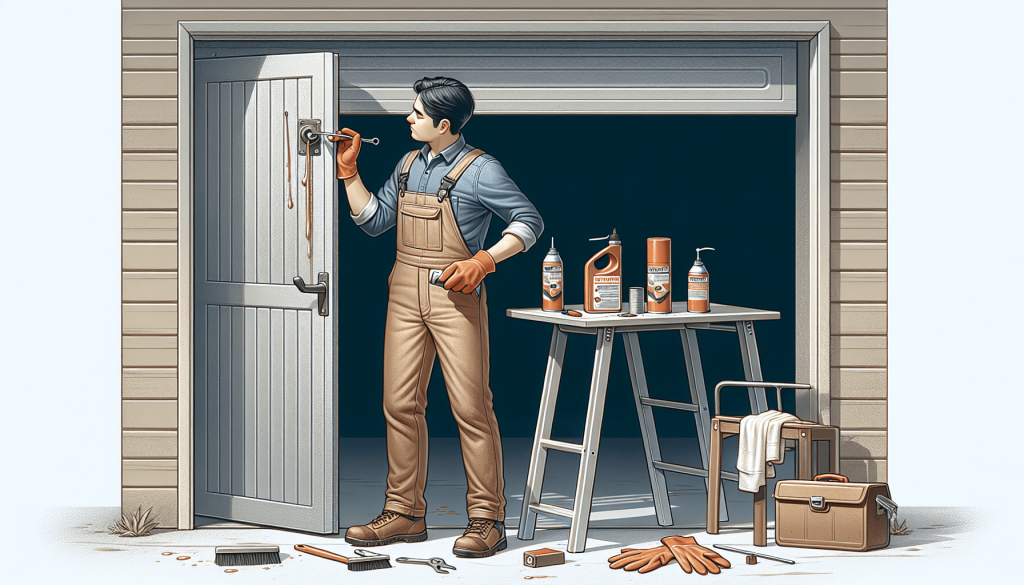
Lubricating the Garage Door Lock
The garage door lock is often overlooked when it comes to maintenance and lubrication. However, proper lubrication of the lock is essential to ensure smooth and secure operation.
Understanding why locks need lubrication
Your garage door lock consists of various moving parts, including pins and tumblers, which can become stiff or jammed over time due to friction or dirt buildup. Lubricating the lock helps to reduce this friction and ensure the smooth operation of the locking mechanism. A well-lubricated lock is less prone to sticking or jamming, providing you with peace of mind and enhanced security.
Steps to safely lubricate the lock
To safely lubricate your garage door lock, start by applying a small amount of lubricant directly into the keyhole. Use a key or a thin, flexible applicator to insert the lubricant into the lock mechanism. Then, slowly insert and remove the key several times to distribute the lubricant throughout the lock’s moving parts. This will help to loosen any stuck pins or tumblers and ensure that the lubricant reaches all the crucial areas. Be careful not to use too much lubricant, as it may cause the lock to become slippery and affect its proper functioning.
Preventing lock damage during lubrication process
When lubricating your garage door lock, it’s important to take precautions to prevent any damage or mishaps. Avoid using excessive force when inserting or removing the key, as this can potentially break or bend the key in the lock. Additionally, be mindful of any excess lubricant that may drip onto the surrounding areas, as it can stain or damage surfaces like wood or paint. To prevent any accidental spills or damage, have a cloth or paper towels ready to quickly clean up any drips or excess lubricant that may occur.
Troubleshooting Common Problems
Despite proper lubrication, you may still encounter certain issues with your garage door. By understanding common problems and their potential solutions, you’ll be better equipped to address these issues and ensure the optimal performance of your garage door.
Dealing with a stuck garage door
If your garage door becomes stuck or difficult to open or close, there are a few troubleshooting steps you can take. First, check the tracks and rollers for any obstructions or debris that may be preventing smooth movement. Clean the tracks and rollers thoroughly, removing any dirt or debris that may have accumulated. Once the tracks and rollers are clean, apply lubricant to ensure smooth operation. If the issue persists, it may be indicative of a more significant problem, such as a worn-out spring or a misaligned track. In such cases, it’s best to consult a professional for a proper assessment and repair.
Addressing unusual noises after lubrication
If you notice unusual noises, such as grinding or squeaking, after lubricating your garage door, it may indicate an underlying problem. Inspect the door’s mechanical parts, including the springs, tracks, rollers, and hinges, for any signs of damage or wear. Tighten any loose screws or bolts and ensure that all components are properly aligned. If the noises persist, it’s best to seek professional assistance, as it may be a warning sign of a more significant issue that requires expert attention.
What to do if lubrication doesn’t improve door operation
If you’ve properly lubricated your garage door but notice no improvement in its operation, there may be other factors at play. In some cases, the issue may be related to the door’s balance, alignment, or spring tension, which may require professional adjustment or repair. Additionally, age and wear can also affect the overall performance of your garage door, requiring more extensive repairs or even replacement. If you’ve followed all the recommended lubrication steps and still experience problems with your garage door, it’s best to consult a professional for a thorough inspection and appropriate solutions.
In conclusion, understanding the importance of garage door lubrication is crucial to maintaining the optimal performance and longevity of your garage door. By regularly lubricating your garage door’s mechanical parts, including springs, tracks, rollers, hinges, and lock, you can reduce wear and tear, prevent rust and corrosion, and ensure smooth and quiet operation. By following the proper steps, using the right lubricant, and conducting regular inspections, you can enjoy a well-maintained garage door that operates efficiently and extends the life of your valuable investment.

